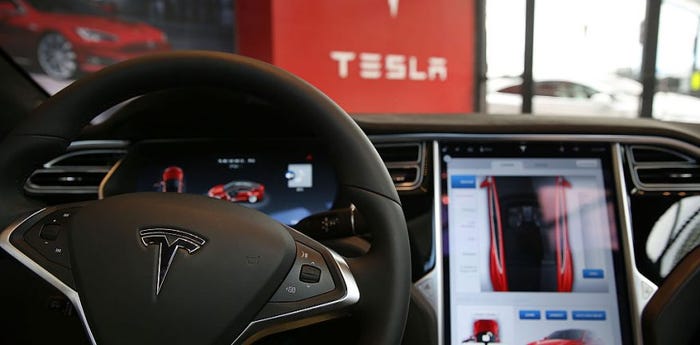Moving Beyond Buzzwords: Making Digital Transformation a Reality
While everyone seems to be talking about digital transformation these days, transforming a business requires a cultural shift rather than just a technological investment.
October 20, 2016

“Technology is the answer. But what was the question?” —architect Cedric Price, 1966
In one respect, saying you want to transform a business digitally is like saying that you would like to travel to Mars. It’s an admirable idea, but where do you start?
From city officials to the traditional tech industry, many professionals aren’t clear on what terms like Internet of Things or digital transformation mean for their business.
Only 27% percent of IT and security professionals say their company is in the middle of a digital transformation, according to a survey from Dimensional Research sponsored by Dell. The vast majority of these professionals—89%—believe that their industry is in the middle of such a transformation. Many of them are fearful as well. Nearly half of them worry that their business will become obsolete in three to five years. And 78% consider digital startups a threat.
The IoT Emerge conference in Chicago in November will feature sessions with all three of these influencers. Code for a Complimentary Expo Pass: IOTEXPOPASS.
The organizations that have succeeded in making digital transformation efforts a reality have done more than invest in technology. They have transformed their culture. As Gartner has observed, the biggest threat to innovation is internal politics. Common pitfalls include lack of tolerance for failure, inability to accept new ideas, and the failure to change.
In this Q&A with several technology influencers, we consider these difficulties and provide advice on how to overcome them.
Why are so many companies struggling with digital transformation?
 Tamara McCleary, CEO of Thulium.co: A big part of this is generational. You have Gen X and Millennials with all of these fresh new creative ideas that are being shot down because many of the people leading these companies are pigeonholed in the old way of doing business. I bump up against this on a daily basis. I see this struggle of old versus new all of the time.
Tamara McCleary, CEO of Thulium.co: A big part of this is generational. You have Gen X and Millennials with all of these fresh new creative ideas that are being shot down because many of the people leading these companies are pigeonholed in the old way of doing business. I bump up against this on a daily basis. I see this struggle of old versus new all of the time.
 Tripp Braden, executive recruiter at Strategic Performance Partners: This is something you see in any adoption cycle. Part of what you are running into is a number of converging issues all at the same time. When you look at IoT for example, you are looking at changing the way people do business. From one perspective, as a strategy guy, you don’t have a clear view of IoT yet, and most of the people you are climbing into it are thinking of it as a commercial venture and not as an earth-shattering venture. The companies that are heavily into it—GE, Parker-Hannifin, Eaton—a lot of these companies are focused on the present, not what they are going to be doing tomorrow morning. A lot of what you are seeing are companies that see this as the next generation of their business but don’t know how to apply it to their business. It is challenging because they cannot always see what the next generation of business looks like. To be candid, many of them are publicly traded and have quarterly projections and have pressures to deliver something that may not be ready for prime time. That might be the only way to keep their stock up.
Tripp Braden, executive recruiter at Strategic Performance Partners: This is something you see in any adoption cycle. Part of what you are running into is a number of converging issues all at the same time. When you look at IoT for example, you are looking at changing the way people do business. From one perspective, as a strategy guy, you don’t have a clear view of IoT yet, and most of the people you are climbing into it are thinking of it as a commercial venture and not as an earth-shattering venture. The companies that are heavily into it—GE, Parker-Hannifin, Eaton—a lot of these companies are focused on the present, not what they are going to be doing tomorrow morning. A lot of what you are seeing are companies that see this as the next generation of their business but don’t know how to apply it to their business. It is challenging because they cannot always see what the next generation of business looks like. To be candid, many of them are publicly traded and have quarterly projections and have pressures to deliver something that may not be ready for prime time. That might be the only way to keep their stock up.
What we have to do is think in terms of ecosystems. Women tend to be more holistic looking in terms of how they look at business. They are looking at the ecosystem. Look at Ginni Rometty from IBM. She is looking at the future and taking a multidimensional approach. We are kind of at an inflection point for leadership, too where a lot of the single-dimensional people are still in charge, and they are holding on for dear life.
Part of this is generational. Many of the people that we thought would be retiring, haven’t. I have spoken with 75-year olds that think they can work at the company forever. Meanwhile, two out of three millennials expect to leave their current employer by 2020, according to research from Deloitte. That’s a huge difference. IoT companies should be thinking about how to train and retain their younger employees. The challenge of leadership is to find a way to create a culture where people want to be more involved in their work. Managers and leaders will need to find ways to engage their workforce more.
Digital transformation requires a more creative way of doing business. It also requires more investment in team members. It’s not about the best technology. People expect great technology.
Your people and their approach to how they do things is the only way of standing out from the crowd. This means finding new ways of developing your different team members in different generations. Having younger team members help older members increase capabilities will pay significant benefits to both people. The younger person will develop better influencing skills that will serve them when they’re in a management position, and they have to convince other members of the team to get things done.
You have four generations in the workforce, and the older generation is very set in their ways and the younger generation is very set in their ways. The only problem is they are different ways.
 Bill McCabe, recruiter and owners of SoftNet Search Partners LLC: There are ways that digital transformation plays out within a specific company’s culture. And there are ways to hire people who will thrive within that culture and in some respects, very quickly learn how to work around cultural hurdles that are not enabling the digitization of the environment. It’s also important to screen for those talented individuals who can balance the need for project management rigor and technical expertise with the ability to be an innovator—having these people in place to lead the IoT goes a long way toward conquering political roadblocks. They’re savvy enough to have facts and figures to back up their next-gen strategies and they can communicate for change.
Bill McCabe, recruiter and owners of SoftNet Search Partners LLC: There are ways that digital transformation plays out within a specific company’s culture. And there are ways to hire people who will thrive within that culture and in some respects, very quickly learn how to work around cultural hurdles that are not enabling the digitization of the environment. It’s also important to screen for those talented individuals who can balance the need for project management rigor and technical expertise with the ability to be an innovator—having these people in place to lead the IoT goes a long way toward conquering political roadblocks. They’re savvy enough to have facts and figures to back up their next-gen strategies and they can communicate for change.
What do you think about how the IoT is marketed?
McCleary: Some of the big tech companies have trouble reaching their target market because they are not using fresh and innovative enough content. If your company wants to move the needle, it has to be bold in the kind of content it uses. A lot of the content for IoT smacks of old-school marketing and advertising.
We need more examples of companies that have succeeded in creating new types of business. Even examples outside of IoT can be helpful. I highlight other companies that have been innovative like the company Tory Burch, which has made themselves relevant not by creating technology but creating things that augment technology. They created this beautiful jewelry that goes over the top of the plastic FitBit, so it converts into something gorgeous.
Nobody wants to sit there and listen to one company talk about themselves. The companies may want to sell their products, but a simple product pitch doesn’t work anymore. You have to talk about the trends that are new and creative, what is changing the world, and the people involved in it. You highlight the one thing you care about most that you want these people to know, and then you get off the topic of yourself. That is how you do it nowadays. You can’t create a forward-thinking vision with yesterday’s eyeballs.
What other kinds of mistakes do you see?
McCleary: The details of exactly how companies are going to capitalize on the IoT has not been talked about much. Instead, nearly everybody is talking about generalities. It is missing the meat of it. It is missing the juice.
I’ve not often seen the vision of the IoT fleshed out. I think we are all still talking in generalities, but I do think it is going to change soon. I think we will have to start talking about specifics because people are getting tired of generalities.
If all of these devices are connected, the businesses that are going to be on top are going to be the ones that control the service piece of it. If a homeowner has a connected home—with a connected alarm, smoke alarm, refrigerator, toaster, everything—who is the service provider? Who ties it all together? That is the organization who has the money—the organization that provides the application for all of these devices.
That applies to autonomous vehicles as well. It is not going to be the manufacture of the vehicles that wins. It is going to be the smart companies who figure out what people are going to be doing in those cars when they no longer have to drive anymore. How can we help them shop or get them dinner or how can we service all of the people that are going to have all of this time on their hands? How do we make their lives easier while they are in their autonomous vehicle?
Things that we can’t conceive of today, we will be talking about five years from now. We are all racing to try to have these future-forward visionary eyes, but the problem is all of us are bumping up against our humanity, which means we judge everything based on a past experience. We are trying to figure out the future based on our experience of the past and it just doesn’t work.
Braden: What we are often forgetting is the people part. If you don’t have a focus on people, you are not going to be sustainable long term.
Uber figured out that people want to be treated differently. They are not just somebody who is taking a ride. They are a person first. And they wanted a better experience. IoT companies should be asking: What is the service we are providing? How does it impact our communities? It is critical to understand what the other person wants so we can provide it. The old idea to just keep sending out messages and hope doesn’t work any longer. There are too many messages for yours to stand out.
McCabe: I like it when Tripp and others bring the IoT equation back to the “people part” — or as Tamara just said—to our humanity. Back in the day, we galvanized around the product-based, external promise of the IoT. The number of customers, markets, potential partners and stakeholders we reach now is astounding. So that’s come to pass and it still is very exciting. That’s the more “mature” sector of the IoT. Now, we have to work on using IoT technologies to micromanage personal relationships. That applies whether that’s between a person’s phone and themselves or between the company and the customer—one customer at a time, or employee, or colleague or wherever they sit, we enable one-to-one connection with the right technology, and that grows loyalty, retention, and real value. From my perspective as a recruiter, I see this person-to-person aspect of the IoT as much more exciting. And when I place leaders in pacesetting companies, the first interviews I have are invariably human-centric — the people I talk to are excited about changing lives, not just changing technologies.
About the Author(s)
You May Also Like

.png?width=700&auto=webp&quality=80&disable=upscale)
.png?width=700&auto=webp&quality=80&disable=upscale)
.png?width=300&auto=webp&quality=80&disable=upscale)
.png?width=300&auto=webp&quality=80&disable=upscale)
.png?width=300&auto=webp&quality=80&disable=upscale)
